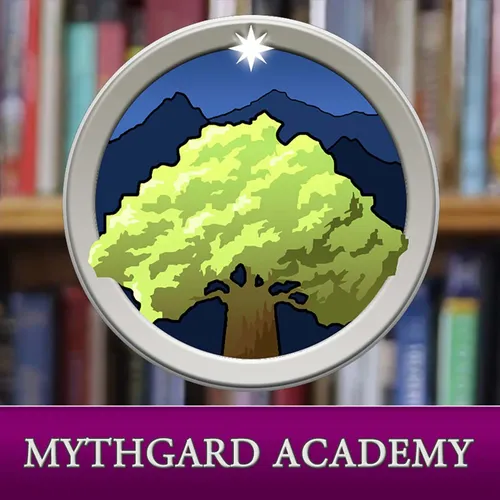
Mythgard Academy
Mythgard Academy aims to make engaging discussions of fantasy and science fiction literature free and open to everyone. The Mythgard Academy program features live discussions with Dr. Corey Olsen, The Tolkien Professor, and other experts on speculative fiction. Books are nominated and voted on by our supporters, and recordings are available for free via podcast and the Signum University YouTube channel.
- Update frequency
- every 11 days
- Average duration
- 116 minutes
- Episodes
- 476
- Years Active
- 2012 - 2025

MSA028: Inferno, Class 20
Week 20: Where we call bologna on Dante’s talent curbing and clearly see the simple summer simile. Where with Ulysses we pass the columns, and the poles, and founder on the shores of Mount Purgatory …

MSA028: Inferno, Class 19
\Week 19: A Place Among the Classics
In the seventh pocket of the eighth circle, the fraudulent thieves are beset with snakes. Dante calls them all serpents, but some have six legs, and some none; s…

MSA028: Inferno, Class 18
Guess what sin is punished by snakes. And cyclical incineration.

MSA028: Inferno, Class 17
Week 17: Now into the second half of the Malebolge, we look back at the closing line of Canto 21 and The Comedy's lack of humor. Then on to Canto 23, where Aesop’s frog and mouse story is called upon…

MSA028: Inferno, Class 16
Tonight we encounter some really ... unexpected demons. What under the earth is going on here?

MSA028: Inferno, Class 15
Week 15: We revisit the Baptistery of San Giovanni and notice the inversions in Dante’s destroying holy furniture to save a life while the popes destroy lives to save holy money for themselves. But w…

MSA028: Inferno, Class 12
Dante Finds Himself Among Friends
Week 12: There are no poor people in rings 8 and 9 of the 7th circle of Hell, but no one sees clearly either. Dante condescends to walk and talk with his old teacher…

MSA028: Inferno, Class 14
Week 14: True to the nature of Fraud, the 8th circle is an artificial construct of inverted imagery split into 10 concentric pockets, with bridges that look down upon each trench. The first pocket is…

MSA028: Inferno, Class 13
Week 13: At the waterfall edge of the 7th circle Dante gives up his belt to conjure a ride. What is the truth which seems a lie? Poetic allegory of course. For Dante breaks the 4th wall to give his p…

MSA028: Inferno, Class 11
Violence Against God
Session 11: Still in the Seventh Circle, in the first ring of the third ring of the Violent, where the violent objector is the landscape itself, fiery sands and flaming rain that…

MSA028: Inferno, Class 10
Concerning Violence
Session 10: Where we arrive on time to find the tormentors of the violent are themselves the violent. The symbolic Nessus, whose own blood became the instrument of the death of hi…

MSA028: Inferno, Class 9
Week 9: Where we stop and notice that the Medieval mind is not modern. And just as the organization of Hell was Aristotlean so too is the nature of physics and philosophy. As Virgil and Dante discuss…

MSA028: Inferno, Class 8
The Mythgard Academy resumes our discussion of Dante's Inferno. Having gotten, with some difficulty, through the Gates of Dis, it is time to enter a new sector of Hell!

MSA028: Inferno, Class 7
Class 7: Where we are reminded that Dante’s frame is a vision and an allegory and not a GPS-enabled map, and even more disturbing there are no bodies in the pageant he sees except his own. Yet, when …

MSA028: Inferno, Class 6
Class Six: Where Boethius and Dante do not understand Fortune, but Virgil does. And three of the 7 deadly sins make their appearance in a swampy, messy, mud wrestling fracas, where souls struggle aga…

MSA028: Inferno, Class 5
Class Five: Where we ask: Does Virgil recognize the shade of Aeneas’ Cerberus, and is his beast being punished here for its own appetite? And does Ciacco really want to be remembered for eternity as …

MSA028: Inferno, Class 4
Class Four: Where we digress, and agree with Aristotle. And then we think about Francesca da Rimini and Paolo and the very tragedy of their romance is the irony of their situation in the Second Circl…

MSA028: Inferno, Class 3
Class three: Dante was a poet of courtly love, and he perfected the art in pursuit of Beatrice; but here in the Inferno, he places her as his patroness in heaven sending him aid. He starts at the gat…

MSA028: Inferno, Class 2
Class Two: Where we set the frame, and meet the sun, and identify the scary beasts. And we see that the political, moral, spiritual, and poetical allegories blend and twist and illustrate each other.…

MSA028: Inferno, Class 1
Mythgard Academy goes to Hell with Dr. Corey Olsen and Dante’s Inferno. Class One starts off the close look at Dante’s masterful poem with a great introduction to the 4-fold interpretation of poetry …